fuel cap CHEVROLET PRIZM 1998 3.G Owners Manual
[x] Cancel search | Manufacturer: CHEVROLET, Model Year: 1998, Model line: PRIZM, Model: CHEVROLET PRIZM 1998 3.GPages: 364, PDF Size: 18.79 MB
Page 129 of 364
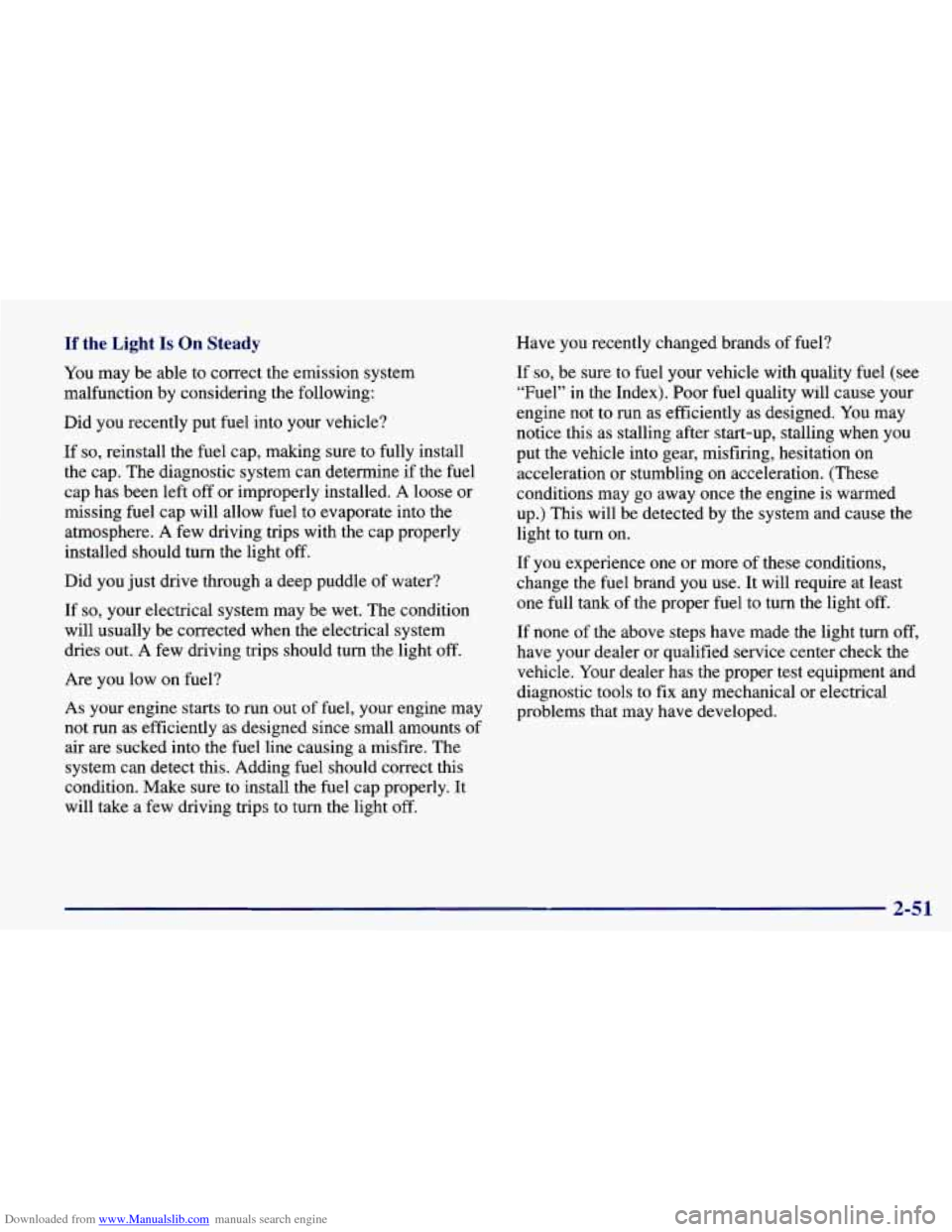
Downloaded from www.Manualslib.com manuals search engine If the Light Is On Steady
You may be able to correct the emission system
malfunction by considering the following:
Did you recently put fuel into your vehicle?
If
so, reinstall the fuel cap, making sure to fully install
the cap. The diagnostic system can determine if the fuel
cap has been left off or improperly installed. A loose or
missing fuel cap will allow fuel to evaporate into the
atmosphere.
A few driving trips with the cap properly
installed should turn the light off.
Did you just drive through a deep puddle of water?
If
so, your electrical system may be wet. The condition
will usually be corrected when the electrical system
dries out.
A few driving trips should turn the light off.
Are you low
on fuel?
As your engine starts to run out of fuel, your engine may
not run as efficiently as designed since small amounts of
air are sucked into the fuel line causing a misfire. The
system can detect this. Adding fuel should correct this
condition. Make sure to install the fuel cap properly. It
will take a few driving trips to turn the light off. Have
you recently changed brands of fuel?
If so, be sure to fuel your vehicle with quality fuel (see
“Fuel” in the Index). Poor fuel quality will cause your
engine not to run as efficiently as designed. You may
notice this as stalling after start-up, stalling when you
put the vehicle into gear, misfiring, hesitation
on
acceleration or stumbling on acceleration. (These
conditions may go away once the engine is warmed
up.) This will be detected by the system and cause the
light to turn on.
If you experience one or more of these conditions,
change the fuel brand you use. It will require at least
one full tank of the proper
fuel to turn the light off.
If none of the above steps have made the light turn off,
have your dealer or qualified service center check the
vehicle. Your dealer has the proper test equipment and
diagnostic tools to fix any mechanical
or electrical
problems that may have developed.
2-51
Page 132 of 364
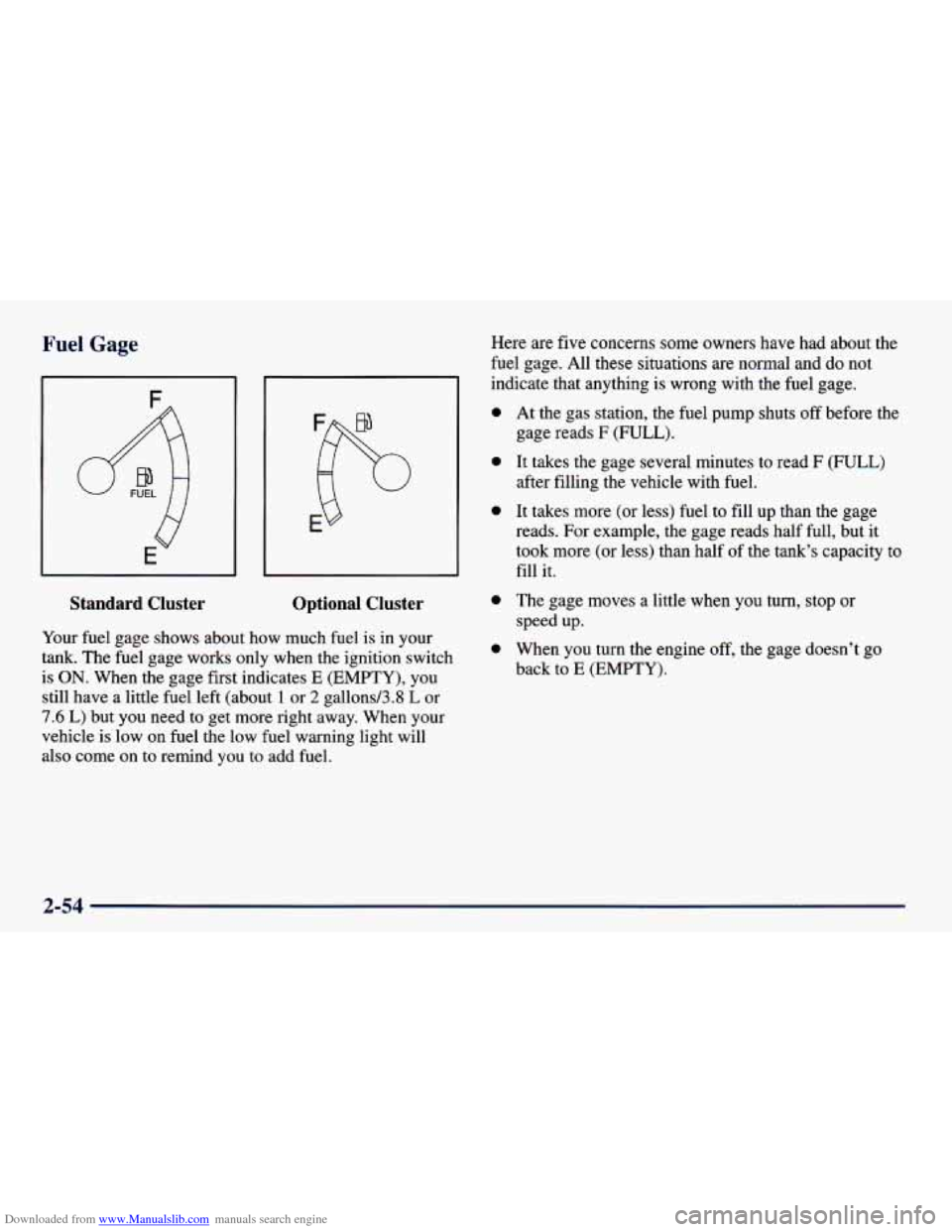
Downloaded from www.Manualslib.com manuals search engine Fuel Gage
q
E
Standard Cluster Optional Cluster
Your fuel gage shows about how much fuel is in your
tank. The fuel gage works only when the ignition switch
is
ON. When the gage first indicates E (EMPTY), you
still have a little fuel left (about
1 or 2 gallons/3.8 L or
7.6
L) but you need to get more right away. When your
vehicle is low on fuel the low fuel warning light will
also come on to remind you to add fuel. Here are
five concerns some owners
have had about the
fuel gage. All these situations are normal and do not
indicate that anything
is wrong with the fuel gage.
0
0
0
0
0
At the gas station, the fuel pump shuts off before the
gage reads F (FULL).
It takes the gage several minutes to read F (FULL)
after filling the vehicle with fuel.
It takes more (or less) fuel to fill up than the gage
reads. For example, the gage reads half full, but it
took more (or less) than half of the tank’s capacity to
fill it.
The gage moves a little when you turn, stop or
speed up.
When you turn the engine off, the gage doesn’t go
back to
E (EMPTY).
2-54
Page 180 of 364
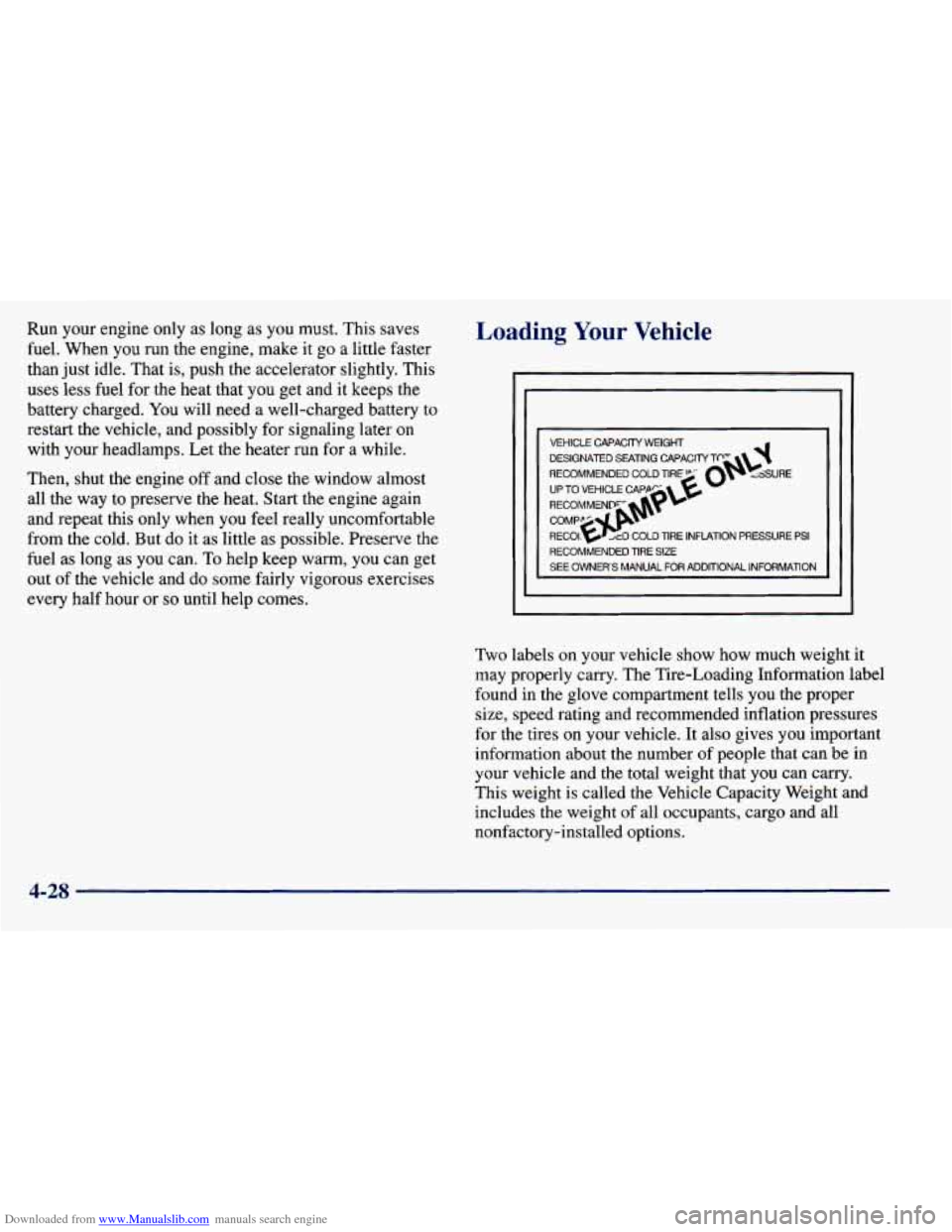
Downloaded from www.Manualslib.com manuals search engine Run your engine only as long as you must. This saves
fuel. When you
run the engine, make it go a little faster
than just idle. That is, push the accelerator slightly. This
uses less fuel for the heat that
you get and it keeps the
battery charged. You will need a well-charged battery to
restart the vehicle, and possibly for signaling later on
with your headlamps. Let the heater run for a while.
Then, shut the engine
off and close the window almost
all the way to preserve the heat. Start the engine again
and repeat this only when you feel really uncomfortable
from the cold. But
do it as little as possible. Preserve the
fuel as long as you can.
To help keep warm, you can get
out
of the vehicle and do some fairly vigorous exercises
every half hour or
so until help comes.
Loading Your Vehicle
VEHICLE CAPACITY WEIGHT
RECOMMENDED TIRE SIZE
SEE OWNER'S MANUAL FOR ADDITIONAL INFORMATION
Two labels on your vehicle show how much weight it
may properly carry. The Tire-Loading Information label
found in the glove compartment tells you the proper
size, speed rating and recommended inflation pressures
for the tires on your vehicle. It also gives you important
information about the number
of people that can be in
your vehicle and the total weight that you can carry.
This weight is called the Vehicle Capacity Weight and
includes the weight
of all occupants, cargo and all
nonfactory-installed options.
4-28
Page 181 of 364
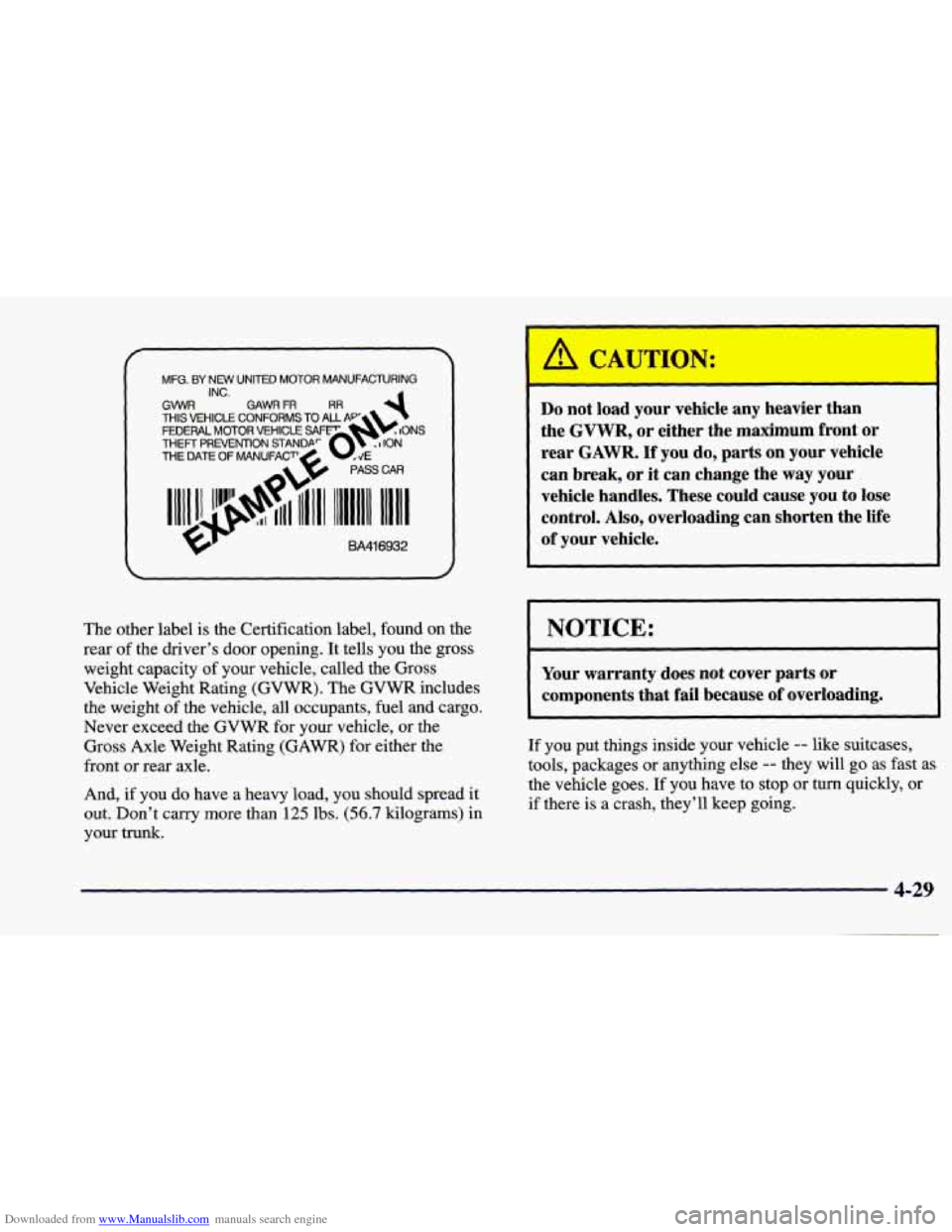
Downloaded from www.Manualslib.com manuals search engine MFG. BY NEW UNITED MOTOR MANUFACTURING
INC.
PASS CAR
EA416932
The other label is the Certification label, found on the
rear of the driver’s door opening. It tells
you the gross
weight capacity of your vehicle, called the Gross
Vehicle Weight Rating (GVWR). The
GVWR includes
the weight of the vehicle, all occupants, fuel and cargo.
Never exceed the
GVWR for your vehicle, or the
Gross Axle Weight Rating
(GAWR) for either the
front or rear axle.
And,
if you do have a heavy load, you should spread it
out. Don’t carry more than
125 lbs. (56.7 kilograms) in
your tnxnk.
Do not load your vehicle any heavier than
the
GVWR, or either the maximum front or
rear
GAWR. If you do, parts on your vehicle
can break, or it can change the way your
vehicle handles. These could cause you to lose
control. Also, overloading can shorten the life
of your vehicle.
I NOTICE:
Your warranty does not cover parts or
components that fail because
of overloading.
~~ ~ ~
If you put things inside your vehicle -- like suitcases,
tools, packages
or anything else -- they will go as fast as
the vehicle goes.
If you have to stop or turn quickly, or
if there is a crash, they’ll keep going.
4-29
Page 183 of 364
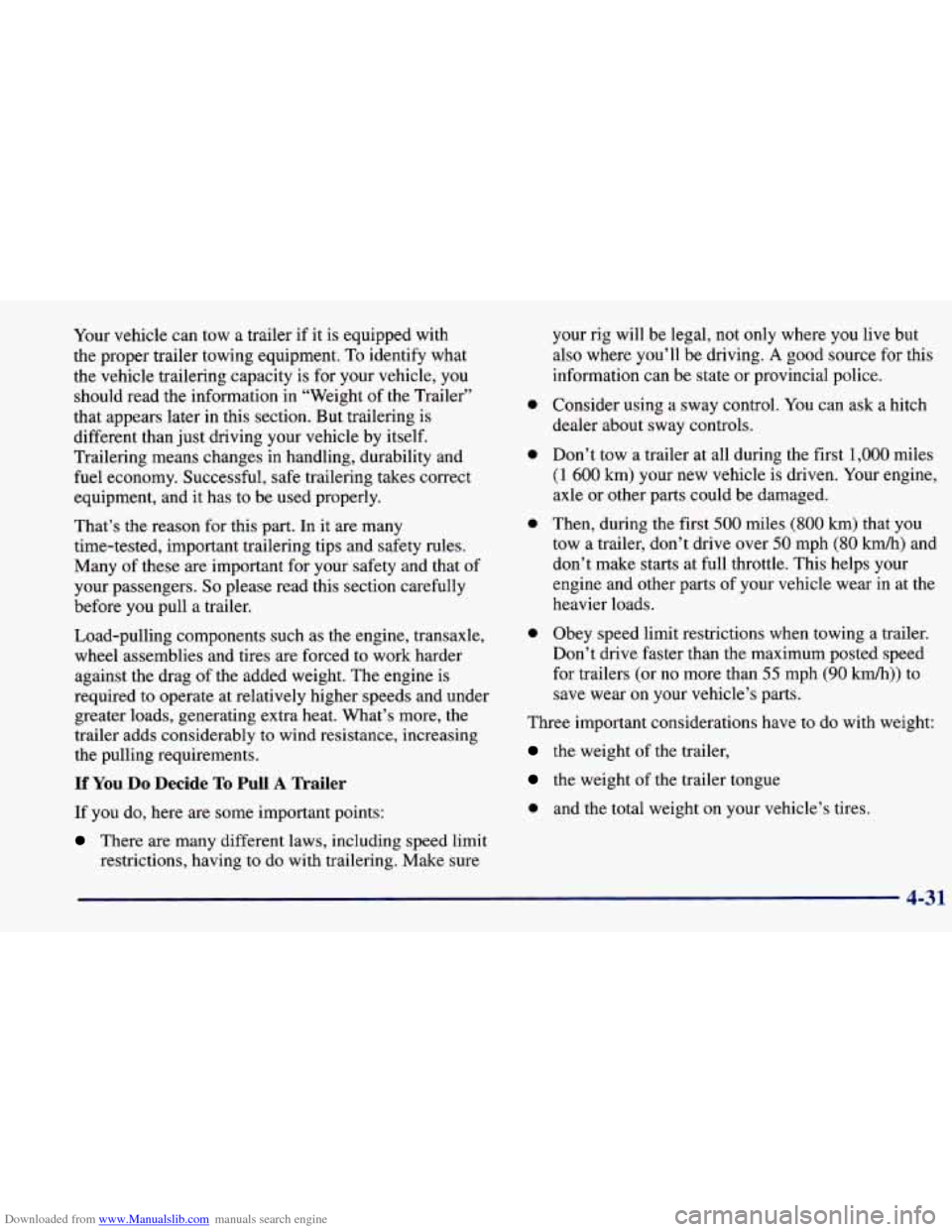
Downloaded from www.Manualslib.com manuals search engine Your vehicle can tow a trailer if it is equipped with
the proper trailer towing equipment. To identify what
the vehicle trailering capacity
is for your vehicle, you
should read the information in “Weight of the Trailer”
that appears later in this section. But trailering is
different than just driving your vehicle by itself.
Trailering means changes in handling, durability and
fuel economy. Successful, safe trailering takes correct equipment, and it has to be used properly.
That’s the reason for this part. In it are many
time-tested, important trailering tips and safety rules.
Many of these are important for your safety and that of
your passengers.
So please read this section carefully
before you pull a trailer.
Load-pulling components such as the engine, transaxle, wheel assemblies and tires are forced to work harder
against the drag
of the added weight. The engine is
required to operate at relatively higher speeds and under
greater loads, generating extra heat. What’s more, the
trailer adds considerably to wind resistance, increasing
the pulling requirements.
If You Do Decide To Pull A Trailer
If you do, here are some important points:
There are many different laws, including speed limit
restrictions, having to do with trailering. Make sure
0
0
0
0
your rig will be legal, not only where you live but
also where you’ll be driving.
A good source for this
information
can be state or provincial police.
Consider using a sway control. You can ask
a hitch
dealer about sway controls.
Don’t tow a trailer at all during the first
1,000 miles
(1 600 km) your new vehicle is driven. Your engine,
axle or other parts could be damaged.
Then, during the first
500 miles (800 km) that you
tow a trailer, don’t drive over 50 mph (80 km/h) and
don’t make starts at
full throttle. This helps your
engine and other parts of your vehicle wear in at the
heavier loads.
Obey speed limit restrictions when towing a trailer.
Don’t drive faster than the maximum posted speed
for trailers (or no more than
55 mph (90 km/h)) to
save wear on your vehicle’s parts.
Three important considerations have to do with weight:
the weight of the trailer,
the weight of the trailer tongue
0 and the total weight on your vehicle’s tires.
Page 227 of 364
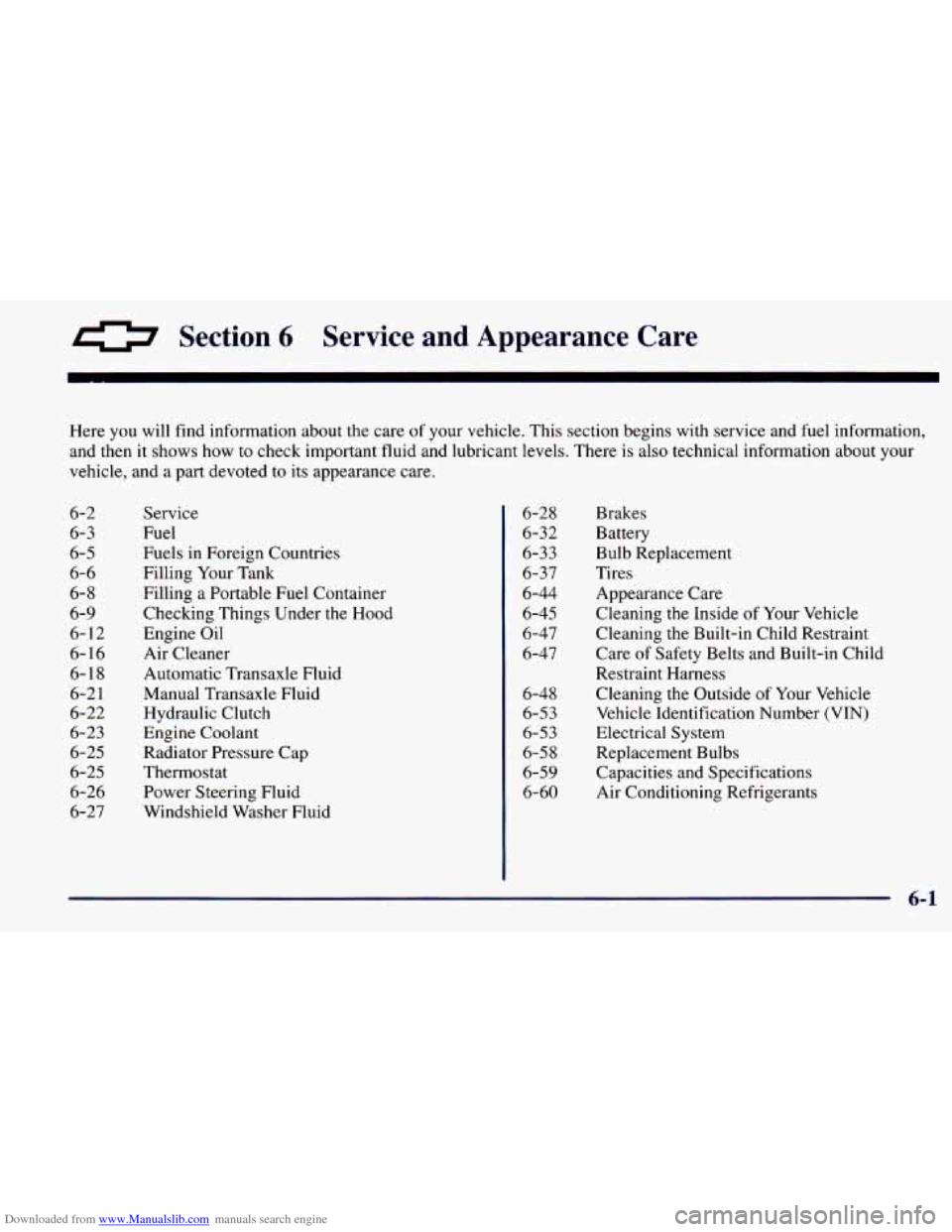
Downloaded from www.Manualslib.com manuals search engine 0 Section 6 Service and Appearance Care
Here you will find information about the care of your vehicle. This section begins with service and fuel information,
and then
it shows how to check important fluid and lubricant levels. There is also technical information about your
vehicle, and
a part devoted to its appearance care.
6-2
6-
3
6-5
6-6
6-
8
6-9
6-12
6-16
6-18
6-2
1
6-22 6-23
6-25
6-25
6-26
6-27
Service
Fuel
Fuels in Foreign Countries
Filling Your Tank
Filling a Portable
Fuel Container
Checking Things Under the Hood
Engine Oil
Air Cleaner
Automatic Transaxle Fluid
Manual Transaxle Fluid
Hydraulic Clutch
Engine Coolant
Radiator Pressure Cap
Thermostat Power Steering Fluid
Windshield Washer Fluid
6-28
6-32
6-33
6-37
6-44
6-45
6-47
6-47
6-48
6-53
6-53
6-5
8
6-59 6-60
Brakes
Battery
Bulb Replacement
Tires
Appearance Care
Cleaning the Inside
of Your Vehicle
Cleaning the Built-in Child Restraint
Care of Safety Belts and Built-in Child
Restraint Harness
Cleaning the Outside of Your Vehicle
Vehicle Identification Number
(VIN)
Electrical System
Replacement Bulbs
Capacities and Specifications
Air Conditioning Refrigerants
Page 233 of 364
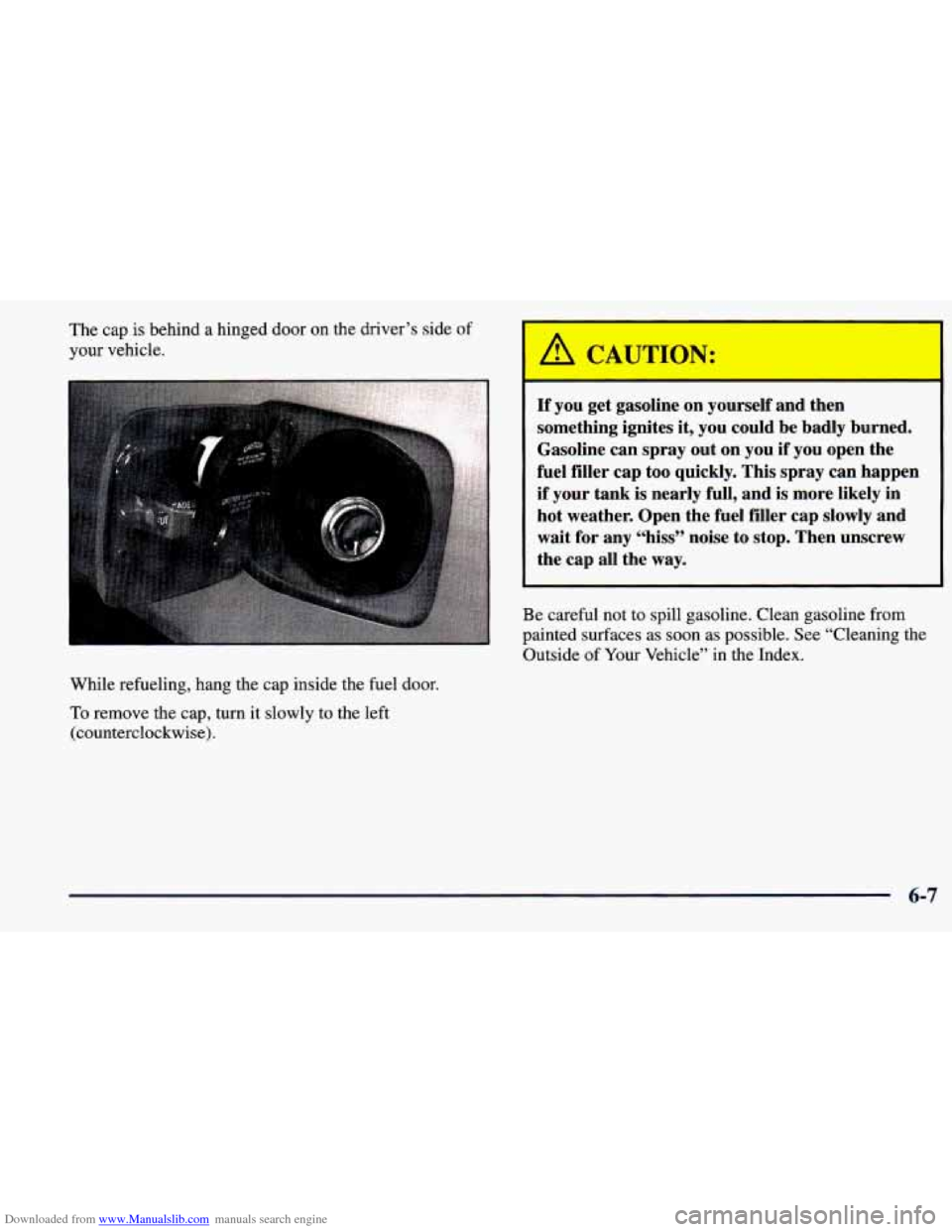
Downloaded from www.Manualslib.com manuals search engine The cap is behind a hinged door on the driver’s side of
your vehicle.
While refueling, hang the cap inside the fuel door.
To remove the cap, turn it slowly to the left
(counterclockwise).
A ,CAUTION
If you get gasoline on yourself and then
something ignites it, you could be badly burned.
Gasoline can spray out on you if you open the
fuel filler cap too quickly. This spray can happen
if your tank is nearly full, and is more likely in
hot weather. Open the fuel filler cap slowly and
wait for any “hiss” noise to stop. Then unscrew
the cap all the way.
Be careful not to spill gasoline. Clean gasoline from
painted surfaces as soon as possible.
See “Cleaning the
Outside of Your Vehicle” in the Index.
6-7
Page 234 of 364
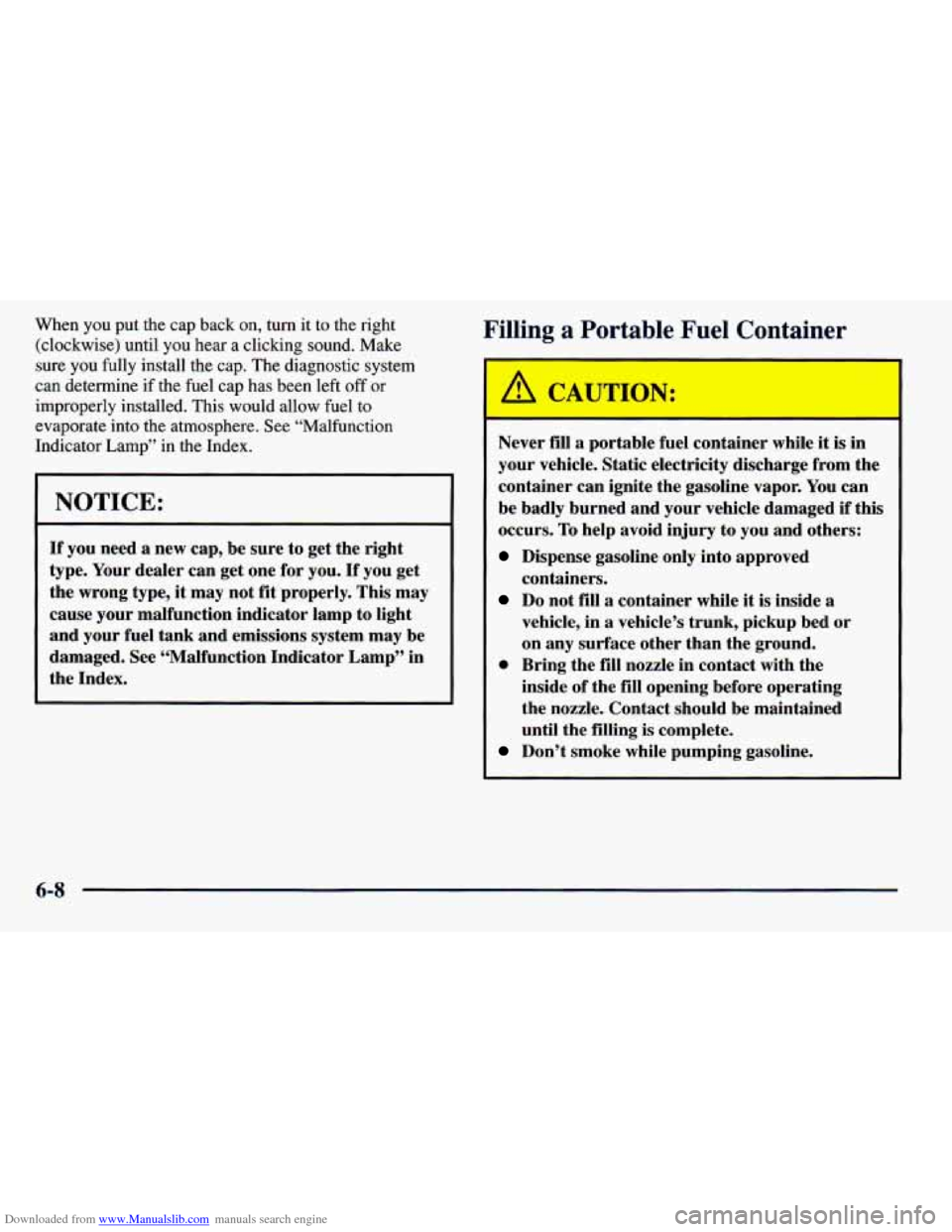
Downloaded from www.Manualslib.com manuals search engine When you put the cap back on, turn it to the right
(clockwise) until you hear a clicking sound. Make
sure you fully install the cap. The diagnostic system
can determine
if the fuel cap has been left off or
improperly installed. This would allow fuel to
evaporate into the atmosphere. See “Malfunction
Indicator Lamp” in the Index.
NOTICE:
If you need a new cap, be sure to get the right
type. Your dealer can get one for you.
If you get
the wrong type, it may not fit properly. This may
cause your malfunction indicator lamp to light
and your fuel tank and emissions system may be
damaged. See “Malfunction Indicator Lamp” in
the Index.
Filling a Portable Fuel Container
Never fill a portable fuel container while it is in
your vehicle. Static electricity discharge from the
container can ignite the gasoline vapor.
You can
be badly burned and your vehicle damaged if this
occurs. To help avoid injury to you and others:
Dispense gasoline only into approved
containers.
Do not fill a container while it is inside a
vehicle, in a vehicle’s trunk, pickup bed or
on any surface other than the ground.
inside
of the fill opening before operating
the nozzle. Contact should be maintained
until the filling
is complete.
0 Bring the fill nozzle in contact with the
Don’t smoke while pumping gasoline.
Page 264 of 364
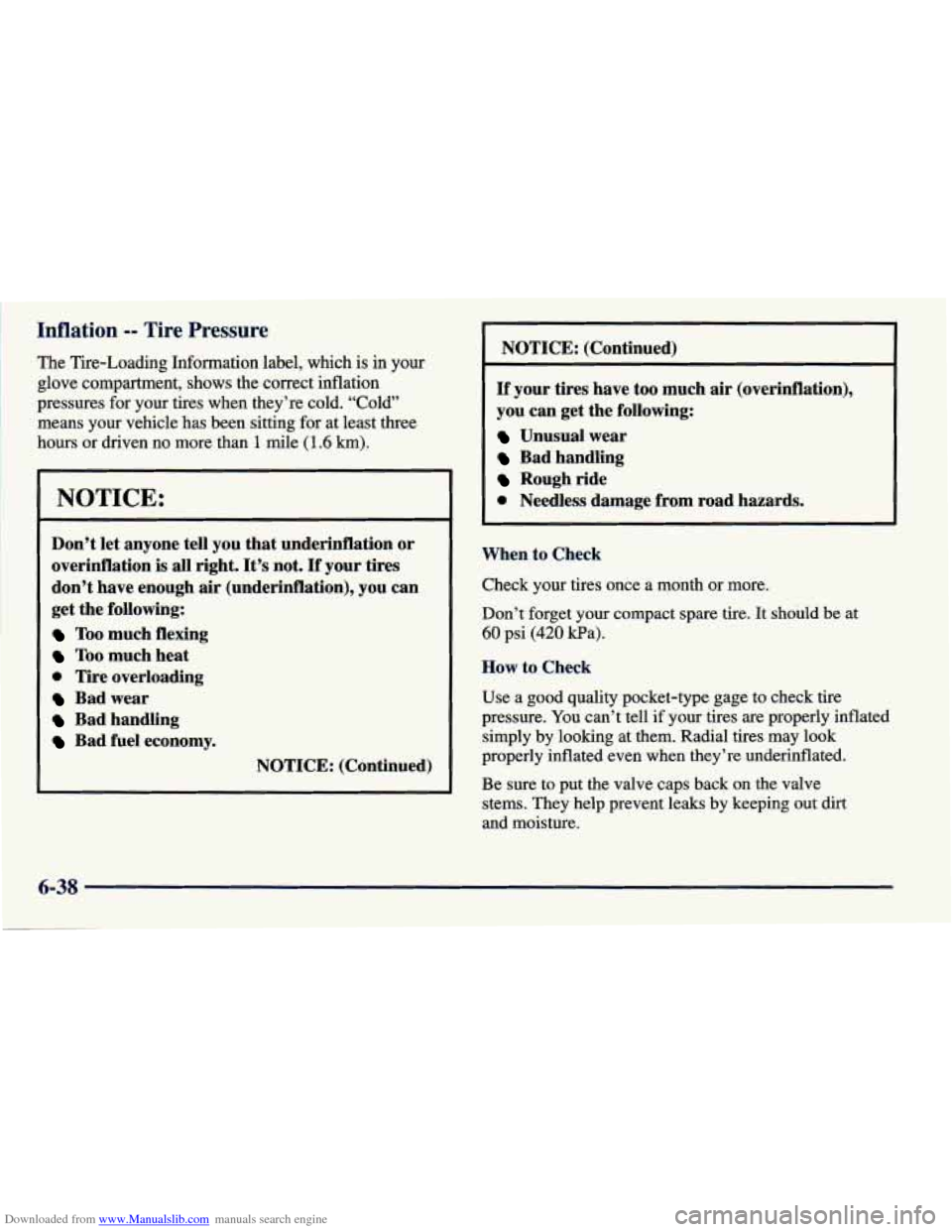
Downloaded from www.Manualslib.com manuals search engine ~ Inflation -- Tire Pressure
The Tire-Loading Information label, which is in your
glove compartment, shows the correct inflation
pressures for your tires when they’re cold. “Cold”
means your vehicle has been sitting for at least three
hours or driven no more than
1 mile (1.6 km).
NOTICE:
Don’t let anyone tell you that underinflation or
overinflation
is all right. It’s not. If your tires
don’t have enough air (underinflation), you can
get the following:
Too much flexing
Too much heat
0 Tire overloading
Bad wear
Bad handling
Bad fuel economy.
NOTICE: (Continued)
I NOTICE: (Continued) I
If your tires have too much air (overinflation),
you can get the following:
Unusual wear
Bad handling
Rough ride
0 Needless damage from road hazards.
When to Check
Check your tires once a month or more.
Don’t forget your compact spare tire. It should be at
60 psi
(420 Wa).
How to Check
Use a good quality pocket-type gage to check tire
pressure. You can’t tell
if your tires are properly inflated
simply by
looking at them. Radial tires may look
properly inflated even when they’re underinflated.
Be sure to put the valve caps back on the valve stems. They help prevent leaks by keeping out dirt
and moisture.
6-38
Page 285 of 364
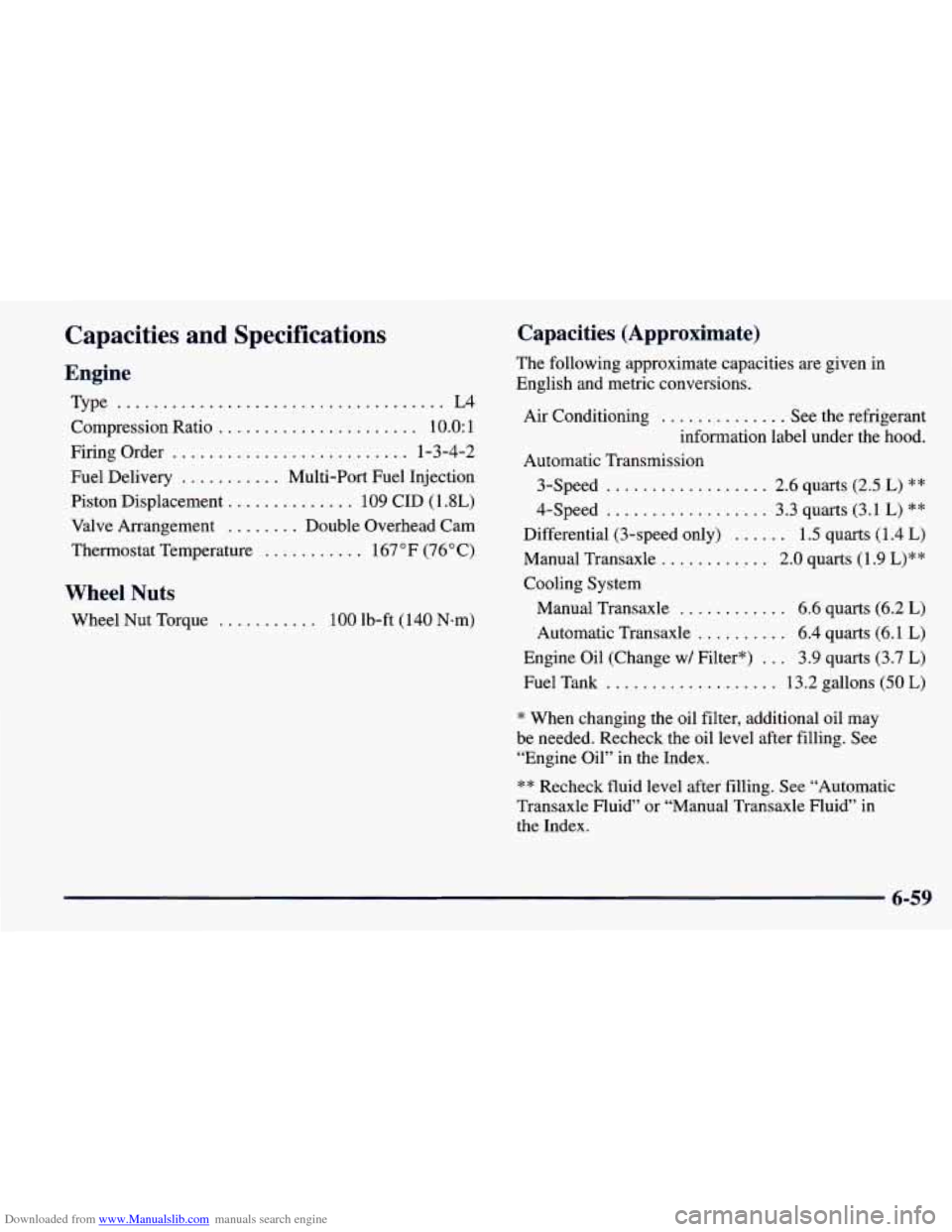
Downloaded from www.Manualslib.com manuals search engine Capacities and Specifications
Engine
Type .................................... L4
Compression Ratio ...................... 10.0: 1
Firing Order
.......................... 1-3-4-2
Fuel Delivery
........... Multi-Port Fuel Injection
Piston Displacement
.............. 109 CID (1.8L)
Valve Arrangement
........ Double Overhead Cam
Thermostat Temperature
........... 167°F (76°C)
Wheel Nuts
Wheel Nut Torque ........... 100 lb-ft (140 Nem)
Capacities (Approximate)
The following approximate capacities are given in
English and metric conversions.
Air Conditioning
.............. See the refrigerant
information label under the hood.
Automatic Transmission
3-Speed
.................. 2.6 quarts (2.5 L) **
4-Speed .................. 3.3 quarts (3.1 L) **
Differential (3-speed only) ...... 1.5 quarts (1.4 L)
Manual Transaxle ............ 2.0 quarts (1.9 L)**
Cooling System
Manual Transaxle
.......... 6.6 quarts (6.2 L)
Automatic Transaxle .......... 6.4 quarts (6.1 L)
Fuel Tank ................... 13.2 gallons (50 L)
Engine Oil (Change w/ Filter*)
... 3.9 quarts (3.7 L)
* When changing the oil filter, additional oil may
be needed. Recheck the oil level after filling. See “Engine Oil” in the Index.
** Recheck fluid level after filling. See “Automatic
Transaxle Fluid” or “Manual Transaxle Fluid”
in
the Index.
6-59